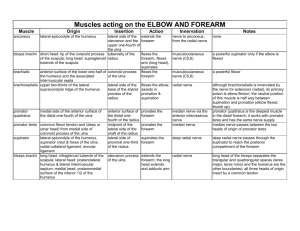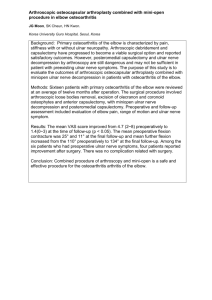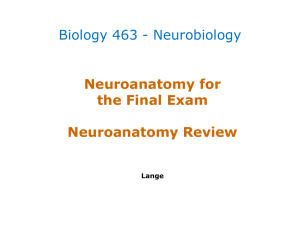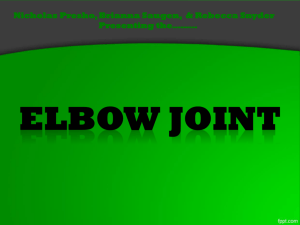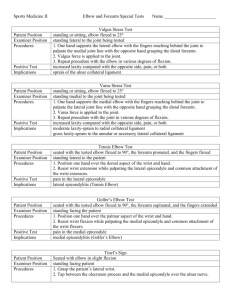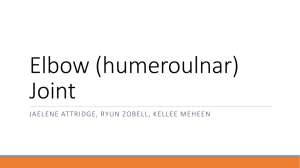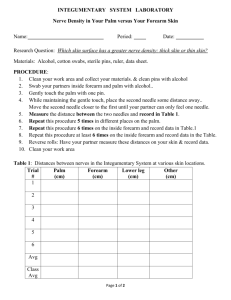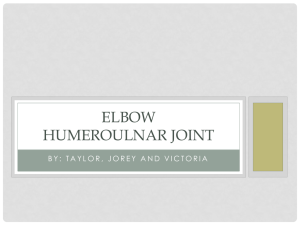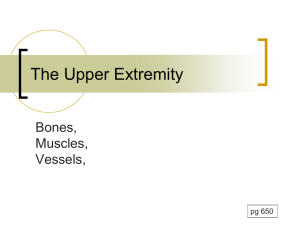The Elbow
advertisement
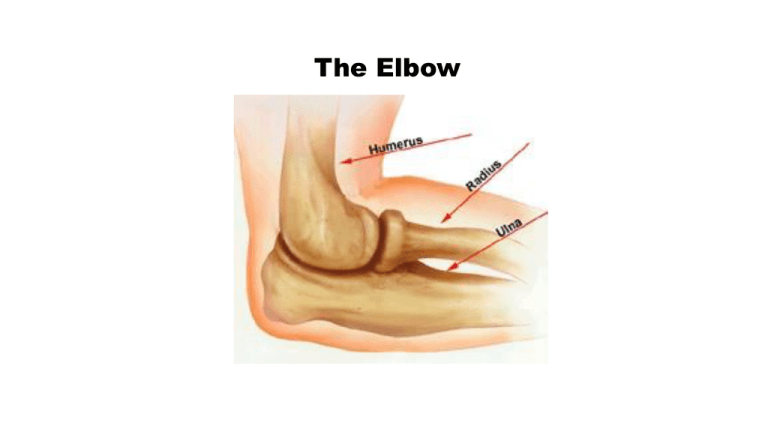
The Elbow Bones • Humerus • Ulna • Radius Humerus • • • • • • Capitulum Trochlea Olecranon Fossa Coronoid Fossa Medial Epicondyle Lateral Epicondyle Ulna • • • • • Olecranon Process Trochlear Notch Coronoid Process Radial Notch Ulnar Tuberosity Radius • Head • Neck • Radial Tuberosity Articular Capsule • Articular Cartilage • Provides smooth, low friction gliding surface • Synovial Membrane • Fibrous layer Ligaments • Articular Capsule • Radial Annular Ligament • Ulnar Collateral Ligament • Radial Collateral Ligament Ligaments • Interosseous Membrane Bursae • Subtendinous Olecranon Bursa • Intratendinous Olecranon Bursa • Subcutaneous Olecranon Bursa Subcutaneous Olecranon Bursa Tennis Elbow • Tennis elbow is caused by either an abrupt or subtle injury of the muscle and tendon area around the outside of the elbow. Tennis elbow specifically involves the area where the muscles and tendons of the forearm attach to the outside boney area (called the lateral epicondyle) of the elbow. • Lateral epicondylitis Fun Video http://youtu.be/RQKQYsiFi6k https://www.youtube.com/watch?v=RQKQYsiFi6k&feature=youtu.be Nerves • Median • Radial • Ulnar • Musculocutaneous Nerves • Musculocutaneous Nerve- It penetrates the coracobrachialis muscle and passes between the biceps brachii and the brachialis, to the lateral side of the arm. A little above the elbow it pierces the deep fascia lateral to the tendon of the biceps brachii and continues into the forearm as the lateral cutaneous nerve of the forearm • Ulnar Nerve- The Ulnar Nerve enters the flexor compartment of the forearm through the flexor Carpi ulnaris and runs alongside the ulnar bone. There it innervates the Flexor Carpi Ulnaris muscle & medial half of Flexor Digitorum Profundus muscle. • Radial Nerve- The radial nerve and its branches provide motor innervation to the dorsal arm muscles (the triceps brachii and the anconeus) and the extrinsic extensors of the wrists and hands; it also provides cutaneous sensory innervation to most of the back of the hand. • Median Nerve- It innervates all of the flexors in the forearm except flexor carpi ulnaris and that part of flexor digitorum profundus that supplies the 2nd and 3rd digits. The latter two muscles are supplied by the ulnar nerve (specifically the Muscular branches of ulnar nerve). Nerves Arteries • • • • • Brachial Artery Deep Brachial Artery Ulnar Artery Radial Artery Superficial Palmar Arch Arteries • Recurrent Interosseous Artery (K) • Anterior Interosseous Artery (L) • Posterior Interosseous Artery (O) Veins • • • • • Brachial Vein Cephalic vein Basilic Vein Median Cubital Vein Median Antebrachial Vein • Dorsal Venous Arch Muscles • • • • • • • Biceps Triceps Brachialis Brachioradialis Supinator Pronator Teres Pronator Quadratus Biceps • Origin: Long Head- supraglenoid tubercle of scapula, Short Headcoracoid process • Insertion: Radial Tuberosity and Bicipital grooves • Actions: supinates forearm and elbow flexion • Nerve: Musculocutaneous Nerve Triceps • Origin: Long Head- infraglenoid tubercle, Lateral Head- Posterior surface of humerus superior to radial groove, Medial Head- Posterior surface of humerus inferior to radial groove • Insertion: Olecranon process of ulna • Actions: Elbow Extension • Nerve: Radial nerve Brachialis • Origin: Distal half of anterior surface of humerus • Insertion: Coronoid process and ulnar tuberosity • Actions: Elbow flexion • Nerve: Musculocutaneous Nerve Brachioradialis • Origin: Lateral supracondylar ridge on the humerus • Insertion: Styloid process of the radius • Actions: Elbow flexion • Nerve: Radial Nerve Supinator • Origin: Lateral epicondyle of humerus and adjacent ulna • Insertion: Anterior surface of the proximal radius • Actions: forearm Supination • Nerve: Radial Nerve Pronator Teres • Origin: Medial epicondyle of humerus and coranoid process of ulna • Insertion: Lateral aspect of radius at its midpoint • Actions: Forearm Supination, assists in elbow flexion • Nerve: Median Nerve Pronator Quadratus • Origin: Distal fourth of ulna • Insertion: Distal fourth of radius • Actions: Forearm Pronation • Nerve: Median Nerve Note: Both Pronator Teres and Pronator Quadratus assist in forearm pronation at opposite ends of the radius to help rotate the radius over. Whereas the Supinator alone (bigger muscle) supinates forearm. Surface Anatomy Surface Anatomy Surface Anatomy • Lateral Epicondonyle • Medial Epicondyle • Radial Styloid Process • Ulnar Styloid Process • Olecranon • Cubital Fossa • Medial Bicipital Groove • Triceps Tendon • Biceps Tendon Carrying Angle •In anatomical position how your elbows bend naturally. Is the name for the angle of the forearms and how they angle away from the body. •In males the carrying angle (10-15 degrees) •In females the carrying angle (15 degrees) (more pronounced) Thank You!!
